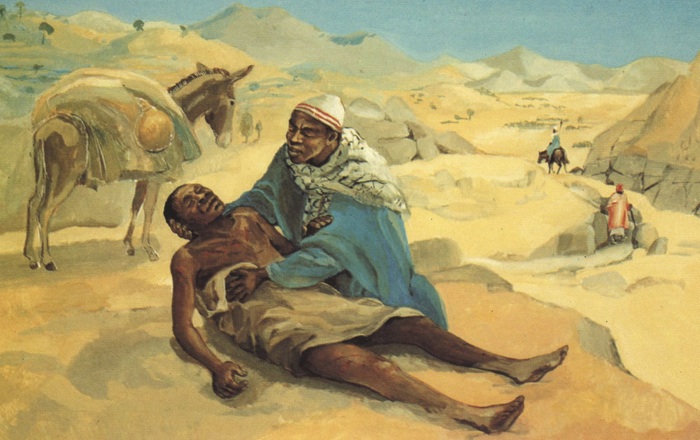Commentary on Psalm 25:1-10
The Good Samaritan text for this Sunday is the equivalent of a fastball right down the middle, and most preachers will want to take a swing at it!
But the lectionary also assigns some other texts for the day, including Psalm 25, which can provide some fresh insight into this well-known story. The psalm contains a request for instruction, and this is exactly what the lawyer asks of Jesus, when he addresses him as “Teacher. . .”
Some Background: A Psalm about Learning and Living
Several features of Psalm 25 indicate that it functioned in a teaching situation. It is, in other words, an instructional psalm (see also Psalm 1, 19, 37, 49, 73, 119, 127, 128 and others). Most obviously, it is an alphabetical acrostic psalm, making it easier to memorize. It goes through each of the 22 letters of the Hebrew alphabet in verses 1-21; verse 22 is outside the pattern and looks like an addition, shifting from “I” to “we” and thus adapting the psalm to use in the congregation.
There are other indications that the psalm was designed for teaching. It expresses an eagerness for instruction: “Make me to know” (verse 4), “teach me”(verses 4, 5), “lead me in your truth” (verse 5). The writer thinks of the Lord as a Teacher, instructing sinners (verse 8), leading and teaching the humble (verse 9), instructing believers on how to live (verse 12).
Framing the instructional core of the psalm are segments suggesting that the context for this instruction was not tranquil. The psalmist has experienced the hatred of enemies and even fears for life itself (verses 1-3, 19-20). The writer is lonely and hurting, needing forgiveness and refuge (verses 11, 16-20). In such a dire situation the psalmist prays for help and sanctuary (verse 20) but also for instruction about the path that the life of a believer ought to take (verses 4, 12).
Some ABC’s of Theological Instruction (verses 1-10)
The lectionary suggests reading only the first ten verses of the psalm, singling out verse 4 as the antiphon or key verse. The psalm begins like a typical lament, containing an affirmation of trust (verses 1-2) and cries for help (verses 2-3) and requesting that the Lord deal with those persons who are making the psalmist’s life miserable (verses 1-3, the ABC or aleph, bet, gimel, the first three letters of this alphabetical plan).
With verses 4 and 5 (dalet and hey, the fourth and fifth letters) the psalm shifts into a series of requests for and reflections on instruction. Notice the imperative verbs: “make me to know your ways… teach me your paths… lead me in your truth… teach me. The psalmist simply doesn’t know what to do next. Daily life is described as a “way” (see also Psalms 1; 16:11; and 119:1-3, 105) and the troubled psalmist needs help figuring out how to proceed along that way. In other words, the psalmist doesn’t know which way to turn or where to go next!
Verses 4 and 5 and 8 (chet) and 9 (yod) picture God as a Teacher, instructing the one who is praying. Here are some examples of a unique kind of theological education. This time God is not the object of the teaching (theology is “talk about God”). Here God is described as the subject, the one who is teaching; God instructs, leads, and teaches.
This psalm uses the three most important biblical words for sin. Those being taught are described as “sinners” in verses 7, 8 (chet, tet), and 18 (qoph, though the text is broken) all using forms of the word hata’ which has the basic sense of missing the target. The word is used literally in Judges 20:16, where the reference is to the seven hundred left-handed slingshot marksmen from the tribe of Benjamin who could fire at a hair and not miss.
Behind the word translated transgressions in verse 7 is the Hebrew pasa’, which means to rebel, like the rebelling of a teenager against parents (Isaiah 1:2) or of one treaty partner against another (2 Kings 1:1; 3:5, 7). The third word, translated guilt in verse 11 (lamed) is from the Hebrew ‘awon which has the sense of being twisted out of shape (Isaiah 24:1) or bent over, bowed down (Psalm 38:6; Isaiah 21:3). Here, then, are three pictures of life that is not right with God: a life that is not headed in the right direction but is off target, a life of rebellion, and a life twisted out of shape.
The section from verses 6-10 says something about the goodness and faithfulness (hesed) of God, which is the basis for the psalmist’s trust and hope. Three times there is reference to God’s steadfast love (verses 6, 7, 10), a translation of the Hebrew word hesed. That word refers to the Lord’s enduring love for the Lord’s people. “For his steadfast love endures forever” occurs as the refrain in each verse of Psalm 136. Here are given examples of God’s steadfast love, including God’s work in creation, in delivering the people from bondage in Egypt, and in guiding them through the wilderness. God’s hesed also includes providing food for all living creatures (Psalm 136:25).
The Lawyer’s Question and the Teacher’s Answer (Luke 10:25-37)
Luke portrays Jesus as in conflict with the “lawyers” or experts in Scripture who appear in his Gospel. The one in Luke 10 is trying to trap Jesus; see also Luke 7:30 and 11:45-52. There has been a long and lively history of teaching and learning in Judaism from its beginnings and continuing on to the present. The instructional psalms provide early examples of that tradition.
Jesus is pictured as going about preaching, healing and teaching. He is often addressed as “Teacher” (Matthew 8:19; 12:38; Luke 7:40; 9:38, etc.). In Luke’s report about the Good Samaritan, Jesus is addressed as “Teacher.” Jesus responds by going about his teaching in a method beloved by all teachers, especially Jewish teachers: Jesus tells a story.


July 14, 2013